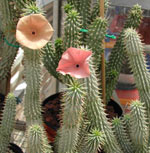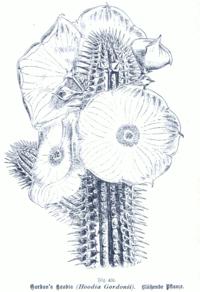
Hoodia. What is it?Hoodia is a Succulent botanical and is part of the Genus: Trichocaulon and belongs to the Family Name: Asclepiadaceae. There are approximately twenty plants within the Hoodia genus family, however, Hoodia Gordonii is the unique plant that South African San bushmen have used for generations to endure long hunting expeditions. Hoodia Gordonii is a leafless spiny succulent plant ( not a cactus ) with fleshly finger-like stems. Rows of thorns are present along the stems, bearing flesh coloured flowers. Hoodia Gordonii grows naturally in the harsh desert conditions of South Africa. Now Hoodia Gordonii has been found in the semi-deserts of Zambia, Zimbabwe, Botswana, Namibia, Angola, the Republic of South Africa, and now found in some other arid regions of South American Nations such as Chili, Peru and some regions of West China including Gansu, Sichuan and Shanxi.
Hoodia researchAfter years of careful research, scientists isolated several compounds in this all-natural food that was responsible for dramatic weight loss, P57, which has been widely reported, is but one of several chemical compounds found in the Hoodia succulent. Not only was it proven completely safe, it contains no stimulates that could contribute to the jittery feeling associated with weight loss products of the last decade. It has been established that the P57 molecule found in wild harvested Hoodia Gordonii works by mimicking the effect that glucose has on nerve cells in the brain in effect fooling the body into thinking it is full, even when it is not, thus curbing the appetite. Mass global interest has been shown for Hoodia since Pfizer, the international pharmaceutical giant, started to research Hoodia's potential to help people with obesity. Pfizer recently discovered Hoodia and decided to invest millions into researching the plants benefits as a new drug that would help with obesity. The research published by this company has catapulted Hoodia into the international spotlight.
Hoodia gordonii nowHoodia is registered as a protected species to prevent Bio-Piracy but is allowed to be grown on a handful of commercial farms in South Africa owned by private farmers. In the wild Hoodia takes 5-6 years to mature but is now being cultivated in as little as 2 years commercially in sustainable quantities and has become widely known for its effects as an appetite suppressant.
How Hoodia help you suppress appetiteHoodia enhances your mood therefore you will not become irritable or weak while you are on the program. The San Tribe could go without food for 24 hours after eating Hoodia, and in the same process hunt for food in the harsh Kalahari desert. It is therefore also known to maintain a high energy level. One of the active ingredients in the herb is a chemical compound called P57, which is thought to be at least partly responsible for the appetite-suppressing effects of hoodia gordonii. But this is probably an oversimplification, since herbs typically work with an assortment of chemical compounds, not just one chemical. For most people, the real weight loss challenge has relatively to do with dieting, exercise, supplements, or how many calories you burn in the gym. The real challenge is controlling their hunger drive. People who are trying to lose weight seem to share the exact same problem. They have trouble getting their appetite under control. Hoodia gordonii, it seems, could make that much easier. Because overcoming your own hunger drive seems almost impossible unless you get some help. When you eat hoodia, the saying goes, your hunger will simply be gone -- gone -- for around six hours. During those six hours, you won't crave anything. You really won't want to eat at all. The food still smells good, as usual, and they taste the same if you eat them, but you don't want to eat them! At least that's what the hoodia advocates claim will happen. Normally, to get your hypothalamus to turn off the hunger switch, you'd have to eat a moderate amount of food. And your hypothalamus isn't very quick on the draw either: it takes around 20 minutes to figure out what you've eaten, and by that time, you've probably eaten another 800 calories. So by the time your hunger signal gets turned off, you've already overeaten yet again. Consuming hoodia is surprisingly simple: slice off a piece of the succulent, peel off the thorns, and just start chewing on it. You don't even need to swallow it. The taste is rather bitter by most Americans' palettes, but after several minutes of chewing, you've already started absorbing the chemical. Guess what? Your hunger is vanishing with each passing moment. The San Tribesmen, the original discovers of the plant, also say it makes you feel stronger, more energetic, and more focused. Nobody complains of any side effects whatsoever, and the plant has been chewed for literally thousand of years by various generations of the San, with no ill effects known whatsoever.
What's Hoodia is correct?Certainly any hoodia company out there that's selling an honest product is conducting a variety of testing, trying to find out who has counterfeit products and who has real products and trying to inform and educate their own customers about the fact that they have the real thing. But, as always, test results offered by companies who have financial interest in proving their product to be genuine simply don't carry the same weight as independent test results from an unbiased third company. Hoodia is also known by horticulture experts as being extremely difficult to cultivate in captivity. The plants rot easily, and they won't grow in regular soil -- they need sandy soil with excellent drainage. Also, to make things even more difficult, these plants aren't pollinated by bees, they're pollinated by flies. To attract the flies, their blooms emit a strong, repulsive odor that smells a lot like rotting flesh. So buying hoodia is very difficult. It's expensive. And, naturally, there are a lot of fakes on the market. Even now, there are only a few hundred acres of hoodia growing on commercial farms, and the plant is highly susceptible to being wiped out by rather mysterious conditions.
Hoodia drugs conjunctionHoodia was eaten as a fresh food by the San tribe for thousands of years with zero side effects. As far as scientists know, there are no negative side-effects. The local san, whose ancestors have been using the plant for thousands of years, claim that there are no negative side effects. So Hoodia can be used in conjunction with prescription medications. The quickness and degree of results will vary depending on the frequency of use and other factors. However, you should start to see the beginning of the weight loss process within two weeks. Please note that the same as with any weight loss supplement, better results will be realized when taken in conjunction with a healthy diet and reasonable exercise.

|